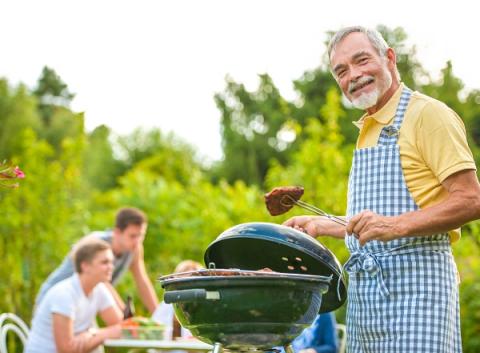Summer Food Safety
Older adults are at a heightened risk for foodborne illnesses because our bodies’ natural defenses tend to weaken as we age. And, older digestive systems take longer to process food, giving potentially dangerous pathogens more time in the body. Half of all people age 65 and older who get a food-borne illness end up hospitalized. So older adults will want to be especially careful with food safety in the summertime.
Keep food at safe temperatures. In hot, humid weather there’s a greater chance for bacteria growth. The danger zone for most bacteria growth lies between 40°F and 140°F, a range that’s often reached during hot summer days. It’s important to be aware of this and take extra precautions when handling food.
When eating outdoors, be mindful of the length of time food stays out in the open. Perishable food should not be left out for more than two hours, or one hour if the outside temperature is above 90°F. After this time, bacteria can multiply quickly, increasing the risk of foodborne illness.
When shopping for groceries, it’s a good idea to make the refrigerated or frozen items the last things you add to your cart. This lessens the time they spend at room temperature before you can refrigerate or freeze them at home. It’s also essential to check the expiration dates of all items and never consume food past its use-by date, even if it looks or smells fine. The bacterium that causes food poisoning doesn’t always alter the taste, smell, or appearance of food.
As for leftovers, they should be refrigerated promptly, not left to cool on the counter. Large amounts of food should be divided into smaller, shallow containers for quicker cooling in the refrigerator. As a rule of thumb, leftovers should be eaten within three to four days. If you’re unsure, it’s always safer to discard questionable food.
Stay clean. One of the fundamental steps toward summer food safety is ensuring good personal hygiene. Washing hands thoroughly before and after handling food, as well as after using the bathroom, sneezing, or touching pets, can significantly reduce the risk of transmitting bacteria to food. In addition to hand washing, cleaning and sanitizing all kitchen surfaces, utensils, and dishes that come into contact with food are also crucial. The process of cleaning removes dirt and food particles, while sanitizing destroys any bacteria that may remain.
Cook foods thoroughly. When cooking, be especially vigilant with meat and poultry. Using a food thermometer is the only reliable way to ensure that these foods are cooked to a safe internal temperature. Remember, color is not a reliable indicator of doneness. For instance, hamburger patties should be cooked to an internal temperature of 160°F, while poultry should reach a temperature of 165°F.
Separate raw and cooked food. When serving, remember to use clean utensils and plates for the cooked food. Never use the same dish that previously held raw meat, poultry, or seafood for anything else unless it has been thoroughly cleaned. This practice helps avoid cross-contamination, which can lead to foodborne illnesses.
The joy of summer dining does not have to be marred by the threat of foodborne illnesses. By adhering to these food safety guidelines, older adults can safely enjoy their favorite summer meals. Remember, when in doubt about a food’s safety, it’s better to err on the side of caution. Health is the most essential ingredient in all our summer fun. So here’s to a delightful, delicious, and safe summer.
